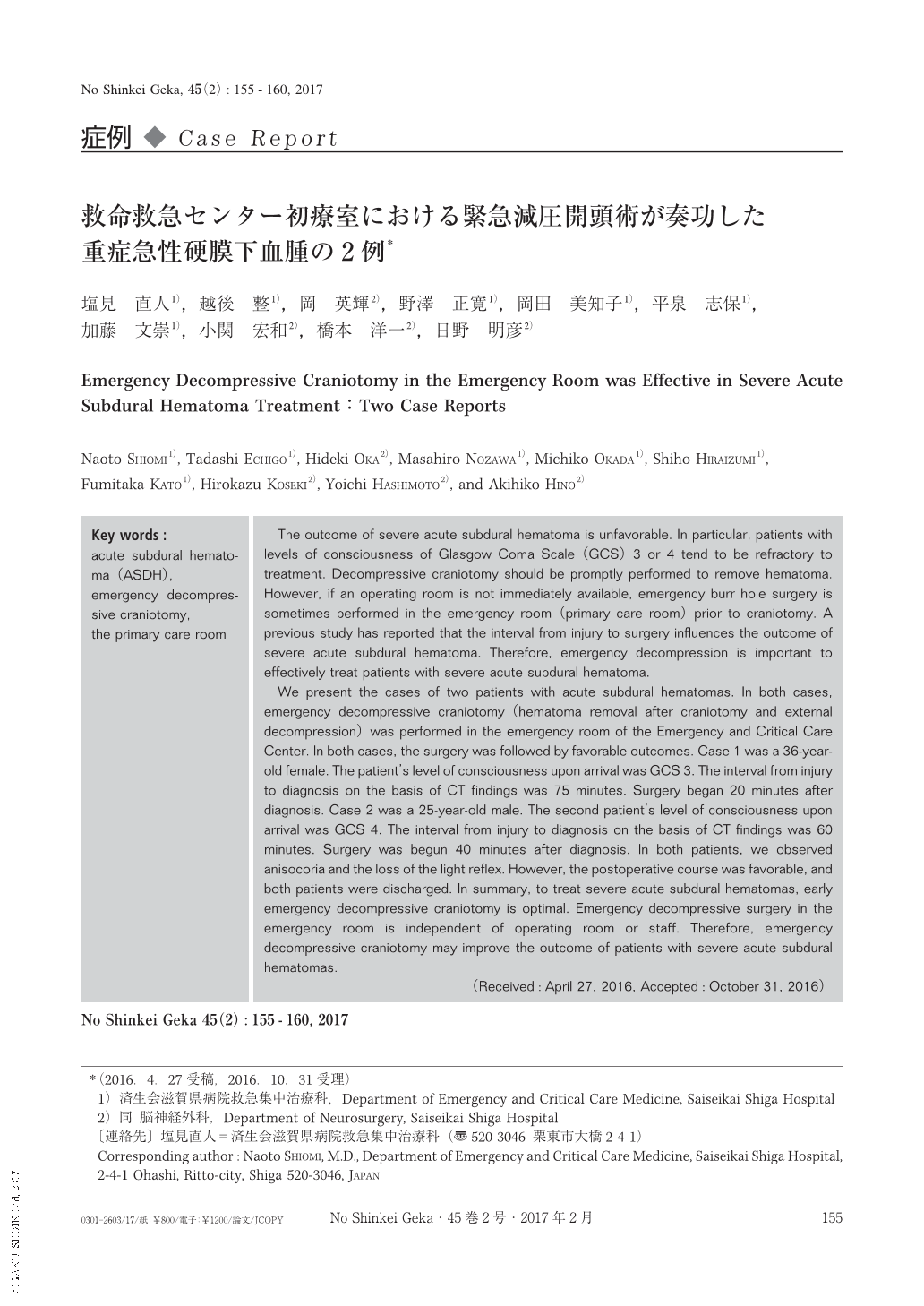Japanese
English
- 有料閲覧
- Abstract 文献概要
- 1ページ目 Look Inside
- 参考文献 Reference
Ⅰ.はじめに
重症頭部外傷の中で急性硬膜下血腫(acute subdural hematoma:ASDH)の転帰はいまだ不良であり,特にGlasgow Coma Scale(GCS)3,4の治療成績は非常に悪いのが現状である5,7,10,21).手術は大開頭による血腫除去が推奨されているが15),手術室の準備までに時間を要する場合などは,開頭術に先行して救命救急センター初療室(以下,初療室)で穿頭を行うこともある3,14,18).手術時期は可及的速やかに行うことが勧められており15),受傷から手術までの時間が転帰に影響を及ぼすという報告がある12,17).
われわれはこれまで,重症の頭蓋内病変は早期の減圧が救命および転帰向上の鍵を握ると考え,初療室における緊急減圧術の有効性について報告してきた19,20).今回,初療室において緊急減圧開頭術(開頭血腫除去術および外減圧術)を施行し,良好な転帰を得た2例のASDHを経験した.いずれも受傷から約100分で手術が開始できており,初療室における緊急減圧開頭術が有効であったと考えられるため,若干の考察を加え報告する.
The outcome of severe acute subdural hematoma is unfavorable. In particular, patients with levels of consciousness of Glasgow Coma Scale(GCS)3 or 4 tend to be refractory to treatment. Decompressive craniotomy should be promptly performed to remove hematoma. However, if an operating room is not immediately available, emergency burr hole surgery is sometimes performed in the emergency room(primary care room)prior to craniotomy. A previous study has reported that the interval from injury to surgery influences the outcome of severe acute subdural hematoma. Therefore, emergency decompression is important to effectively treat patients with severe acute subdural hematoma.
We present the cases of two patients with acute subdural hematomas. In both cases, emergency decompressive craniotomy(hematoma removal after craniotomy and external decompression)was performed in the emergency room of the Emergency and Critical Care Center. In both cases, the surgery was followed by favorable outcomes. Case 1 was a 36-year-old female. The patient’s level of consciousness upon arrival was GCS 3. The interval from injury to diagnosis on the basis of CT findings was 75 minutes. Surgery began 20 minutes after diagnosis. Case 2 was a 25-year-old male. The second patient’s level of consciousness upon arrival was GCS 4. The interval from injury to diagnosis on the basis of CT findings was 60 minutes. Surgery was begun 40 minutes after diagnosis. In both patients, we observed anisocoria and the loss of the light reflex. However, the postoperative course was favorable, and both patients were discharged. In summary, to treat severe acute subdural hematomas, early emergency decompressive craniotomy is optimal. Emergency decompressive surgery in the emergency room is independent of operating room or staff. Therefore, emergency decompressive craniotomy may improve the outcome of patients with severe acute subdural hematomas.

Copyright © 2017, Igaku-Shoin Ltd. All rights reserved.


